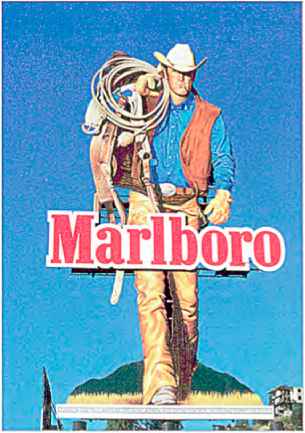Image Differentiation
Buyers respond differently lo company and brand images.'Die primary way to account for Marlboro's extraordinary worldwide market share [around 30 percent) is that Marlboro's "macho cowboy" linage has struck a responsive chord with much of the rigareite-sino-kiu^ public. Wine and liquor companies also work hard to develop distinctive images for their brands.

Image dirieteniiaiinn Tt'.s world-famous WaritMO Man image s Insianuy iöcognijaöle on billboard; and in prW ads
Identity and image need to be distinguished. Identity is the way a company alms to Identify or position itself or its product, ¡wage is the way the public percctYes (he company or its products. Act effective identity docs three tilings: It establishes the product's character and value proposition. Et conveys this character in a distinctive way. It delivers emotional power beyond a menial image. For the identity to work, it must he conveyed through every available communication vehicle and brand contact. It should be diffused in ads, annuo! reports, brochures, catalogs, packaging, company stationery, and business cards. If "IHM means service." this message must be expressed in symbols« colors and slogans, atmosphere, events, and employee behavior.
Even a seller's physical space can be a powerful image generator. 1 lyatr Hegency hotels developed a distinctive image through iis atrium lobbies. Companies can create a strong image by inviting prospccts and customers to visit their headquarters and factories. Boeing, Ben & Jerrys. Hershey's, Saturn, and Crayola all sponsor excellent company tours that draw millions of visitors a year.11 Companies such as i la Ihn ark and Köhler have built corporate m use tuns at their headquarters that display their history and the drama of producing and marketing their products.
"Marketing Memo; Exceeding Customer Expectations" describes one systematic approach to developing a differentiated, customer-orient cd offering.
Product Life-Cycle Marketing Strategies
A company's positioning and differentiation strategy must change as the product, market, and competitors change over die ¡»-athici life cycle (PLC}. To say that a product has a life cycle is io assert four things:
1. Products have a limited life.
2. Product sales pass through distinct stages, each [losing different challenges, opportunities, and problems to the sel I er.
SÎ2 PART J BUILDING STRONG 8RAN
Orego and Schillrin have proposed tliat customer-cenleycd organza-lions should study what cu$1«ners value ant) then prepare an offering ilia! exceeds their expectations. Tfiey sec this as a th-ree-siep process;
1. Defining the customer value model: The company lift lists a' I the product and service factors mat mignt influence the target customers' perception of value.
2, Building the custonier value hierarchy; The company ¡is.'.1 assigns eacfi factor lo one of four groups: basic, expected, desired, and unanticipated. Consider she set of factors ai a fine resfaurartt
&iSj'c:Tlie 1<xd is edible snd lowered in a tirnel/ fashion. il mis is all me resiatram does right, me customer would normally noi be satisheo.)
■ Expected: There is good cfiina and labteware. a linen table-ciom and napkin, flowers, discreet service, ant) wofl-prepar-ed food, fThese factor? make the offering acceptable, Cul not exceptional.}
■ Desired: Hie restaurant a pleasam and quiet, and Itie food is especially good and interesting.
Unanticipated: Hie resiauranl serves a conip imeniary sor bet between the courses and places (SMy on the table after me last course is served.
3. Deckling on the customer value package: No* the company tiiooses that combination of tangible and <ntan$ibl$ hems, experiences, and onlcomes designed lo ousperform canpetllws and win ibe customers' delighi and toyally
Edwin I. Creoi Jr. and Peter D. StniHrin, Q&totner Centeied Rcengiiyering (ftanewood, 1: twin, 1995}.
3. Profits rise and In 11 at different Stlgi'i of the product life cycle.
4. Products require different marketing, tlnancial. manufacturing. purchasing, and lui man resource strategies in each life-cycle sia^e.
Product Life Cycles
Most product life-cycle curves are portrayed as hell-shaped [See Fi j|Uit 10.11. Mils (urve is typically divided inm 1'our stages: intro duel ion, groulli, maturity, and decline.—
L. introduction period of slow sales growth ¡is the product is introduced in the market. Profits arc nonexistent because of the heavy expenses of product introduction.
2. Growth -A period of rapid market acceptance and substantial profit improvement.
3. Maturity-r\ slowdown in sales growth because the product lias achieved acceptance by most potential buyers, profits stabilize or decline because of increased compétition.
4. Decline - Sales show a downward drift ami profits erode.
The I'i.li concept can be used to analyze a product category [liquor], a product fortn (white liquor), a product [vodka), or a bra:id (Smirnoff). Mot all products exhibit a bell-sha;>cd PLC.2'Three common alternate patterns arc slidnvn in inouïe 10.2.

lifliKKlucliwi Growth Maturity
Time lifliKKlucliwi Growth Maturity
Time
Online
Continue reading here: Product Line Length
Was this article helpful?